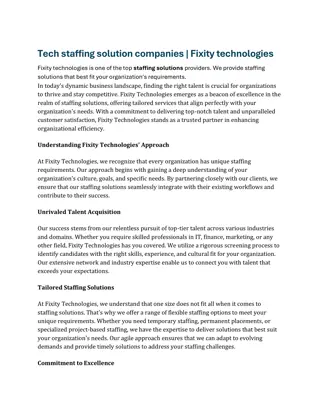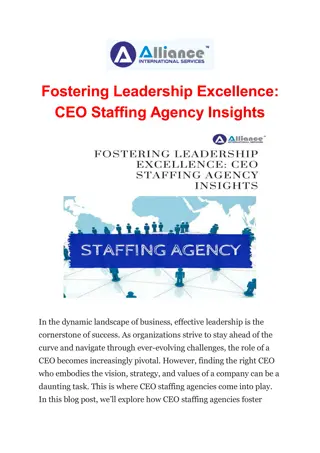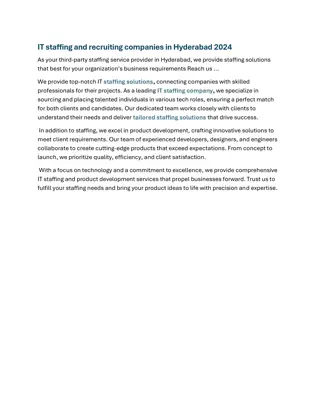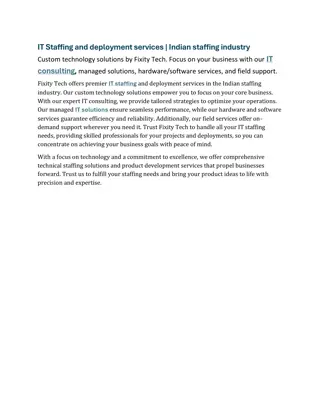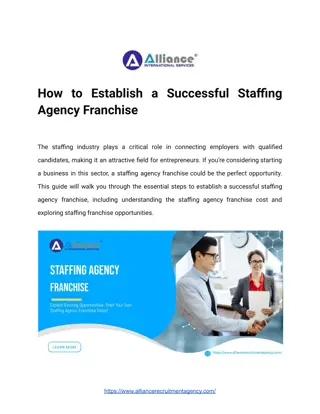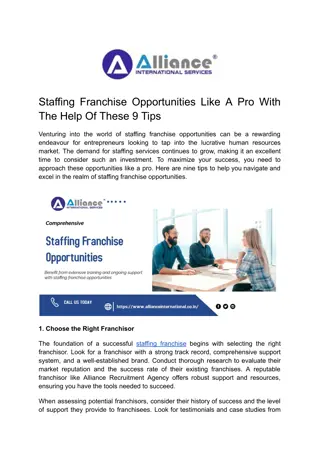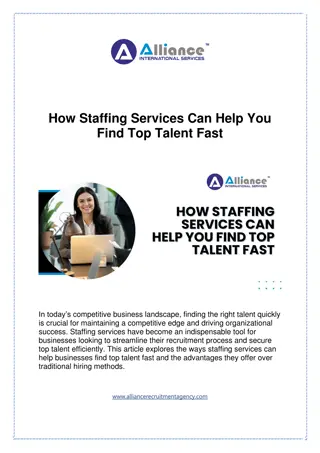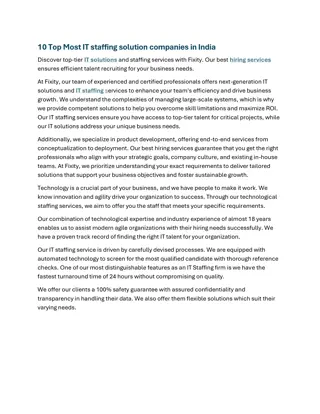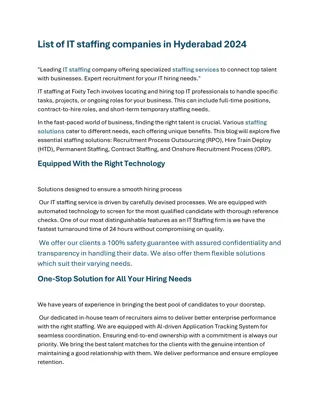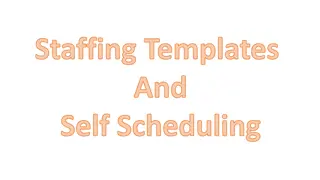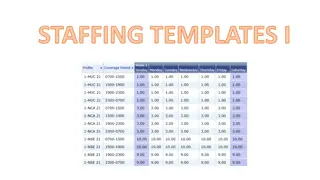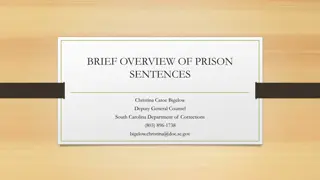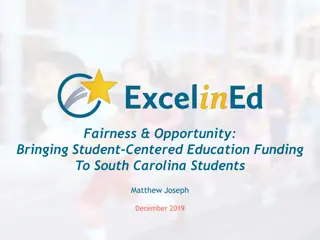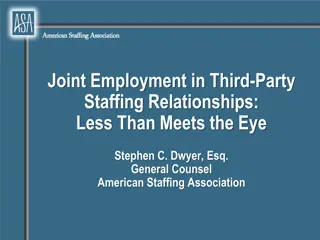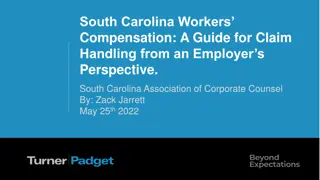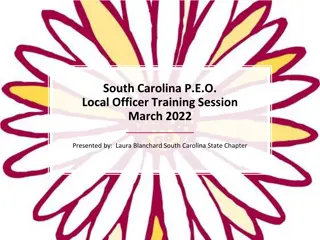Special Education Staffing Requirements and Guidelines in South Carolina
Special Education staffing in South Carolina is guided by state and federal requirements, emphasizing collaboration between fiscal, human resources, and special education departments. Regulations outline caseload limits for teachers and therapists, ensuring proper support for students with disabilities. Understanding these guidelines is essential for creating effective staffing plans in school districts.
Download Presentation

Please find below an Image/Link to download the presentation.
The content on the website is provided AS IS for your information and personal use only. It may not be sold, licensed, or shared on other websites without obtaining consent from the author. Download presentation by click this link. If you encounter any issues during the download, it is possible that the publisher has removed the file from their server.
E N D
Presentation Transcript
Staffing for Special Education: State and Federal Requirements 2019 SCASBO Fall Conference November 6, 2019
Supporting the Mission and Vision of the SCDE Mission The mission of the SC Department of Education is to provide leadership and support so that all public education students graduate prepared for success. Vision All students graduate prepared for success in college, career, and citizenship. By 2018, at least one school in every district will have implemented personalized learning that supports students meeting the Profile of the South Carolina Graduate. OSES supports the SCDE mission statement and vision by ensuring that all students with disabilities in SC have available a free appropriate public education (FAPE) in order to be ready for success in college, careers, and citizenship.
Profile of the South Carolina Graduate
What Does It Take to Appropriately Staff What Does It Take to Appropriately Staff Special Education in School Districts? Special Education in School Districts? Collaboration between fiscal, human resources, and special education departments! Review staffing assignments Regularly discuss student counts, populations changes/trends, and school scheduling Anticipate future needs and shortage areas Work together on planning for recruitment and retention
Caseload Limits in State Regulations S.C. Code of Regulations 43-205 Caseload limits are in the South Carolina Code of Regulations, Chapter 43, Article 17, Section 205 (SC Legislature website at www.scstatehouse.gov) Sets limits for special education teachers in self-contained classes, special education teachers providing resource services, and speech and language (and when teaching assistants are required) Limits vary based on grade range (pre-K to 5, 6-8, 9-12) and disability category (also has cross-category limits) Limits for special education teachers are described in terms of student to teacher ratios (e.g., 15:1) Resource teacher limit is generally 33 students but can be smaller for certain student populations (e.g., visually or hearing impaired, moderate to severe intellectual disabilities)
Caseload Limits in State Regulations S.C. Code of Regulations 43-205 Caseload limits for self-contained classes range from 10 to 18 students depending on grade and disability type (example: middle school emotional disability class student to teacher ratio cannot exceed 15 to 1) Speech language therapists have caseload maximum of 60 When OSES reviews special education teacher staffing we look at an unduplicated count of students (i.e., a student would be listed only on the primary/case manager teacher s caseload even if the student receives services from more than one special education teacher) To be the primary/case manager for a student, the teacher must provide specialized instruction to the student When OSES reviews for speech services, we look at how many students receive services from the provider
Teacher Certification Requirements Required Credentials for Professional Staff Members in the Instructional Programs of South Carolina s Public Schools available on the SCDE website at: https://ed.sc.gov/educators/certification/certification-legislation- and-policy/required-credentials-for-professional-staff-members/ Teachers providing services to students with disabilities must be appropriately certified Acceptable certification for a special education teacher is determined by the area of disability in which all or the majority of the teacher s students (i.e., caseload) are classified Example: If a majority of students in a self-contained class fall under the primary disability category of emotional disability, the teacher must have Special Education: Emotional Disabilities (2E), Special Education: Multi-categorical (2I), or Generic Special Education (02) certification
Federal Requirements - IDEA Federal law and regulations requires local educational agencies to provide a free appropriate public education (FAPE) Part of this requirement is to ensure that special education and relate services are provided in accordance with each student s individualized education program (IEP) Specialized instruction and services such as speech and language therapy, occupational therapy, and physical therapy must be provided with the time and frequency designated and in the manner designated (location, individual or small group, etc.) by the IEP A teacher or service provider may be under caseload limit but unable to fulfill the requirements of the IEPs of the students assigned to them
The Option of Contracting for Services Can use private organizations or other public agencies Contractual relationship District is still responsible for the provision of FAPE Contract must include clear description of services being provided (time, frequency, and location) and ensure contractor adherence to privacy laws (e.g., FERPA) May be only viable solution due to shortages Some contracted services are being performed remotely (e.g., teletherapy)
Adding a Twist: Co-Teaching Co-teaching is when the instructional planning and the delivery of instruction is done collaboratively (together as a team) by a general education teacher and a special education teacher Benefits: maximizes LRE, combines expertise of teachers, allows for more differentiated instruction Several students can receive specialized instruction at one time in co-teaching model Scheduling can be challenging and may require a smaller caseload (typically for resource teachers) to implement
IDEA Fiscal Considerations Related to Staffing Maintenance of Effort (MOE) Time and Effort (for employees who do not work exclusively with students with IEPs) Use appropriate coding when using IDEA funds Look for more information (resources, webinars, etc.) on Coordinated Early Intervention Services (CEIS) as this could impact available funds for staffing for some districts in the future
IDEA Budgeting Remember that LEA MOE is a balancing act, as the LEA you are required to exhaust all of your Federal IDEA funds within the Tydings Period (27 month grant cycle). Additionally, you are required to maintain a level of budgeting (eligibility) and spending (compliance) for non-Federal funds to uphold the requirements of LEA MOE. So with each hire, please take into consideration for new or existing special education staff the impact it will have for IDEA both on the Federal and non-Federal side of the house. What funding stream should be utilized for their position?
IDEA Budgeting Please keep in mind that flexibility is needed for special education staffing and any unexpected events in your special education population that occur at the LEA level (i.e. a costly child moves into the district, do you have the budget flexibility to cover equipment etc. needed to provide FAPE?) As an LEA if we have too much of our 611 or 619 funds dedicated to salary and fringe are we at risk of not being able to provide all that is necessary under IDEA? How much general fund can we use to support the program? The rubric used by the FGM team at OSES takes into account multiple factors when weighing risk. One of the many factors that the team will check is what % of 611 funds are used solely for personnel costs?
Scoring Rubric for Risk Assessment Item Score = 2 Score = 1 Score = 0 Self Assessment On-time Complete Late and/or Incomplete Further explanations are required Submission of application/ documents On-time Complete Late and/or Incomplete Corrections or explanations are required Submission of other data On-time Complete Late and/or Incomplete Corrections or explanations are required LEA MOE Expanded Calculator version 1.4 On-time Complete Late and/or Incomplete Calculations do not match documentation Monitoring of Expenditures Expenditures submitted quarterly Expenditures submitted less than quarterly Expenditures submitted at end of year/large balance at end of year Budgeted for Personnel 75% or less 76-89% Greater than 90%
Takeaways Takeaways Staffing limits/requirements for special education are determined by the students being served and their educational needs Understanding and knowing current student population data is critical (e.g., numbers for each grade, disability type, and instructional delivery model) Also critical to know teacher certification and experience with respect to instructional delivery models and to identify staffing gaps If HR, Fiscal, and Special Ed don t communicate and update each other there could be big problems









